|
|
Welcome to issue 16 of Practice and Process. We took a break in June during the General Election campaign and so have returned with a plethora of practice guide updates. We also have our latest Ask Adam question, a focus on two more of our Top 10 Tips videos and news of an upcoming refresh of our RXC form and a new webinar on our evidence of identity requirements.
|
|
PG6

|
|
When did it change?
17 June 2024
What has changed?
We have amended sections 4 and 7.
What does it mean for customers?
We have updated our guidance to explain how the well-established rule of survivorship affects joint proprietors and that personal representatives of a deceased joint proprietor are not entitled to be registered as proprietors.
|
|
PG8

|
|
When did it change?
17 June 2024
What has changed?
We have amended section 12.
What does it mean for customers?
The contact details for our Commercial Arrangements Section have changed.
|
|
PG9

|
|
When did it change?
3 June 2024
What has changed?
We have amended section 7.
What does it mean for customers?
The amended guidance reflects that, in practice, we will accept a single certification, covering the whole document, that a copy power of attorney is a true copy of the original power.
|
|
PG11

|
|
When did it change?
13 May 2024
What has changed?
We have amended sections 4.2 and 6.11.
What does it mean for customers?
We can now send and receive documents electronically up to 40 megabytes in size.
|
|
PG
14A
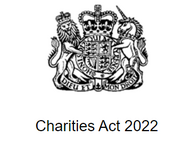
|
|
When did it change?
28 May 2024
What has changed?
We have removed section 3.8.1 (and the subsequent sub-section has been renumbered).
What does it mean for customers?
A charitable incorporated organisation had trust status conferred on it by section 32 of the Charities Act 2022. It is therefore not necessary for a charitable incorporated organisation to apply for a Form A restriction where it is a sole trustee.
|
|
PG19
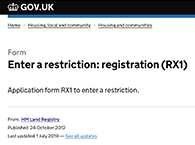
|
|
When did it change?
13 May 2024
What has changed?
We have amended section 3.4.5.
What does it mean for customers?
We have clarified who can and who cannot normally apply for the registration of a consent restriction (for example a restriction in standard Form N).
It will not normally be possible for an applicant to demonstrate they have a sufficient interest in entering a consent restriction if:
- they are not the proprietor; and
- they do not have the proprietor’s consent; and
- they do not fall within rule 93(n), (o), (p), (q), (s) or (t) of the Land Registration Rules 2003.
|
|
PG19

|
|
When did it change?
17 June 2024
What has changed?
We have amended section 3.7.5.
What does it mean for customers?
Our amended guidance explains that a sole or surviving proprietor will need to appoint one or more new trustees to join in the disposition so a Form A restriction can be cancelled by way of overreaching.
|
|
PG24

|
|
When did it change?
17 June 2024
What has changed?
We have amended section 5.1.1.
What does it mean for customers?
We explain that when land is held on trust and a sole (surviving) proprietor remains, a personal representative of a deceased proprietor has no power to deal with the legal estate or act with the surviving proprietor unless formally appointed as a trustee of the legal estate.
|
|
PG26

|
|
When did it change?
28 May 2024
What has changed?
We have amended sections 7 and 10.
What does it mean for customers?
We have clarified our requirements on determination of a lease by effluxion of time and by notice under section 25 or 27 of the Landlord and Tenant Act 1954.
Where a lease has determined by notice given under section 25 or 27 of the Landlord and Tenant Act 1954, we require separate confirmation that those provisions have been complied with.
|
|
PG30

|
|
When did it change?
17 June 2024
What has changed?
We have amended section 3.
What does it mean for customers?
The contact details for our Commercial Arrangements Section have changed.
|
|
PG31

|
|
When did it change?
17 June 2024
What has changed?
We have amended section 2.11.
What does it mean for customers?
The contact details for our Commercial Arrangements Section have changed.
|
|
PG43
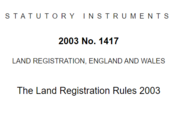
|
|
When did it change?
7 May 2024
What has changed?
We have amended section 1.
What does it mean for customers?
Our guidance has been amended to refer to the current list of persons/bodies qualifying under rule 140(1) of the Land Registration Rules 2003 to inspect and obtain copies of documents, or to make a search of the Index of Proprietors’ Names in connection with the matters referred to in section 1.
|
|
PG52

|
|
When did it change?
13 May 2024
What has changed?
We have amended section 4.2.
What does it mean for customers?
We have clarified that a statement of truth or statutory declaration supporting a prescriptive easement must show continuous use up until immediately prior to the application being made.
|
|
PG62

|
|
When did it change?
28 May 2024
What has changed?
We have amended section 12.2.3.
What does it mean for customers?
We have included references to case law relevant to the abandonment of easements (Williams v Usherwood (1983) 45 P&CR 235 and Gotobed v Pridmoore [1971] EG 759).
|
|
PG63
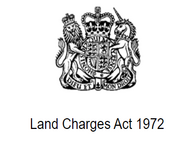
|
|
When did it change?
13 May 2024
What has changed?
We have amended sections 5.1 and 5.2.
What does it mean for customers?
We have clarified our requirements of applications for the cancellation of land charges and the difficulties arising in satisfying the registrar that a land charge has been discharged, overreached or is of no effect.
|
|
PG68

|
|
When did it change?
28 May 2024
What has changed?
We have amended section 5.
What does it mean for customers?
Minor amendments to our guidance have been made to clarify our practice and requirements on our power to amend documents under rule 130 of the Land Registration Rules 2003.
|
|
PG76

|
|
When did it change?
7 May 2024
What has changed?
We have amended section 8.3.
What does it mean for customers?
The amended guidance reflects our updated practice where dealing with existing Form K restrictions when a charging order is assigned.
An application for alteration to update the restriction should be made on the basis that the right or interest protected by the restriction has been transferred. This is to create consistency with practice on updating other types of restrictions where the interest has been assigned.
|
|
PG76
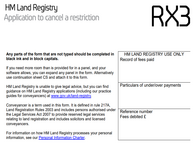
|
|
When did it change?
28 May 2024
What has changed?
We have amended section 8.3.
What does it mean for customers?
Our guidance has been amended to clarify how to apply to remove a Form K restriction when the judgment debt has been assigned to a third party.
Where a judgment debt has been assigned to someone other than the beneficiary named in a Form K restriction, and the restriction has not been updated following the assignment, the assignee may apply to cancel (rather than withdraw) the restriction. Application should be made on form RX3 accompanied by supporting evidence of the assignment of the debt.
This has been done to create consistency with practice on updating other restrictions when there has been an assignment of the interest.
|
|
Process changes

|
|
Coming soon – new RXC form
HM Land Registry’s voluntary form RXC, which you can use to comply with many standard and non-standard restrictions, is being refreshed to bring significant benefits to customers.
A new version will be introduced in the coming weeks and, although we will still accept older form RXCs, this will be the only version available on GOV.UK.
Based on internal and external feedback, the refreshed RXC introduces changes to panels 3 and 5. These are designed to further reduce the need to raise requisitions and avoid delays in the processing of applications.
Part A of panel 3 has been redesigned with fewer options to choose from, including a simpler way for you to indicate that you are providing a consent or certificate on behalf of your client.
If you are not a conveyancer but an employee of a conveyancing firm, the revised form also includes an option for you to confirm that you are providing a consent or certificate on behalf of your employer.
Panel 5 has also been simplified and for the first time includes specific wording to comply with a Form LL restriction.
The new RXC will come complete with updated guidance in Practice Guide 19, including a quick-reference table showing how to complete panel 3 correctly, and examples of how to fill in the form in various scenarios.
We’ll let you know when the form launches – look out for further updates!
Changes to our address for service policy and practices
In our May issue we informed you about forthcoming changes to our policy on addresses for service. The changes have now come into effect, as we explain in our latest blog.
|
|
|
MJ Williams, Mike Williams Surveys: Dear Adam, some title registers mention conveyances dating back several years. Do HMLR keep copies of these, and is it possible to obtain this information?
Adam: There’s no simple or general answer to this question but the key point to understand is that HM Land Registry is not a deeds repository.
When land and property is first registered, we create a register that, as a bare minimum, refers to the location and the legal ownership.
We may refer to specific deeds or documents or, in some cases, include extracts of them in the register; alternatively, we may refer to the deed as being ‘filed’.
In each instance, we may have a copy on file or scanned electronically, but that’s not always the case. Sometimes, we have returned the deed to the applicant at the time an application was made, and occasionally, the ‘filed’ deed cannot be located.
There are a couple of indications in a register that can help determine whether or not we have a copy of a cited deed:
- If the register states it is ‘filed’, then we should have a copy which can be applied for.
- If the register refers to an extract, then it is very unlikely we have a copy of the actual deed.
See our online guidance on how to get information. You may also find our Where are my title deeds? blog of additional interest.
|
|
|
New webinar on our evidence of identity requirements
Register for our latest free webinar on our evidence of identity requirements, which is available on demand, so you can sign up and watch it at any time, whenever you’re ready.
This 35-minute webinar is aimed at business customers and covers:
- the background to our evidence of identity requirements;
- the types of applications that require confirmation of identity;
- accounting for identity on application forms;
- exceptions to the requirements for confirmation of identity;
- exceptions to the requirements where this is not practicable;
- the requirements for forms ID1, ID2 and ID3;
- common errors with forms ID1 and ID2;
- form ID5; and
- confirmation of identity where an attorney is acting.
|
|
 |
|
Join our customer webinars |
|
 |
|
Are you using the Digital Registration Service? |
|
 |
|
Have you read our Strategy 2022+? |
|
|
|
|
|